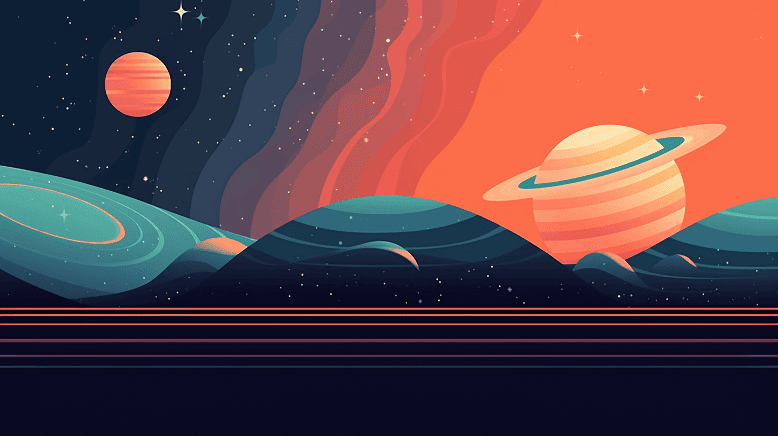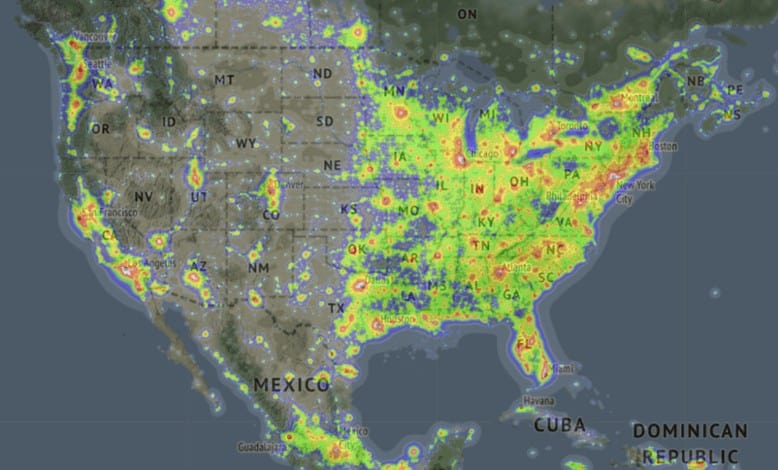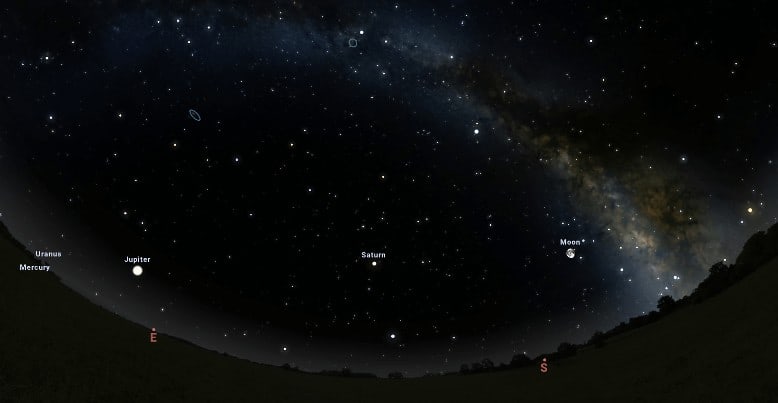Getting started in astronomy can be intimidating for a beginner.
Is that a star or a planet I’m looking at? Do I need a telescope or something else?
In truth, it’s very easy to get started and there are some great free tools and cheap gear that you can use to get going.
We’re going to tell you all about them right now – let’s get into it.

What is Astronomy and Why Do It?
Astronomy is the branch of science investigating all phenomena that occur beyond Earth’s atmosphere – i.e. space and the cosmos.
It is both:
- An academic pursuit
- A hobby that can be pursued by anyone.
In terms of the academic side, you have NASA, other space agencies, and research institutes examining and investigating what they can see and learn from the data gathered from telescopes on Earth, space telescopes like Hubble and the James Webb Space Telescope, and other space exploration means.
It’s a comprehensive examination of everything that exists in space, including planets, stars, asteroids, comets, nebulae, galaxies, and the cosmic microwave background.
As a hobby, it is something that literally anyone can do by looking up to the skies.
Why is Astronomy Important?
Astronomy plays a vital role in our understanding of the universe and our place within it:
- Astronomy has significantly influenced technology, culture, and our understanding of physics. For example, technologies developed for space telescopes have found their way into everyday life, in things like smartphones and medical imaging.
- Astronomical phenomena have informed numerous cultural practices, myths, and navigation techniques.
- Astronomy has been a driving force behind many fundamental physics theories, such as general relativity. It has provided substantial evidence for the Big Bang Theory and continues to shape our understanding of concepts such as dark matter and dark energy.

Astronomy as a Hobby
We live on a teeny tiny planet that spins and hurtles around space at 1000 miles per hour. We can stand on the side of our planet and look up and see countless stars, planets, and other objects.
The size of space and the universe is almost unfathomable.
There are over two trillion galaxies in the observable universe and our galaxy – the Milky Way – contains around 400 billion stars. Our Sun is just one of these stars, and Earth is just one planet in our Solar System.
See How Many Planets Are There in the Universe? for more on this.
There’s so much to be fascinated and excited about, and learning about this is an awesome, mind-expanding thing to do and can easily be picked up by anyone – regardless of age, gender, nationality, or anything else.
Astronomy as a hobby encourages lifelong learning. It’s a field where constant discoveries and advances are being made, and even amateur astronomers can contribute to this body of knowledge.
There are many citizen science projects where hobbyists can help track asteroids, discover exoplanets, or analyze galaxy forms.
You can do as little as look up and ponder or you can follow the latest developments and discoveries. It’s up to you.
What Equipment Do You Need To Start Stargazing?

Stargazing with the Naked Eye
The naked eye can see a surprising amount when stargazing. You can see:
- Stars: Watch them pop through as the skies get darker and your eyes adjust
- The Moon: Changing nightly in its various phases
- Constellations: Like Orion and Ursa Major – apps can help you identify these
- Planets: Mars, Venus, Jupiter and more can be seen easily in the night sky. They will mostly look like stars but the way to tell them apart is that stars twinkle but planets do not
- The Milky Way: Under dark skies with little light pollution you can view our galaxy’s core as a faint band across the sky
- Shooting stars: Streaking through the night sky. Look out for specific dates of meteor showers
- International Space Station: The ISS can be easily seen and certain apps can help you time this
- Satellites: Increasingly so with more going up all the time

Stargazing with Binoculars
For a closer look at the sky, binoculars are a fantastic starting point. They are relatively inexpensive, portable, and versatile.
There are a range of very good binoculars for astronomy that are tailored for night sky observing.
Binoculars can show you much more detail on the Moon, bring out the colors in bright stars, and reveal larger and brighter nebulae and galaxies.
When choosing binoculars for astronomy, consider their specifications. The numbers on binoculars, like 7×50 or 10×50, denote magnification and aperture:
- Magnification is how much larger the object will appear compared to the naked eye. Anything over 10x will need to be used with a tripod or else the view will be too unsteady (because it magnifies your hand shake as well as the view)
- Aperture (in mm) is the diameter of the lens. A larger aperture gathers more light, making fainter objects visible. The bigger this is the better in terms of views, but bigger also means heavier and more expensive.
See the Best Binoculars for Astronomy for more on this.
For other low-cost and portable options, you can consider:

Stargazing with Telescopes
When you’re ready to delve deeper into astronomy, a telescope is the natural next step.
In contrast to binoculars, monoculars or spotting scopes, these are specifically designed for the purposes of astronomy and stargazing (and maybe astrophotography).
There are various types of telescopes, but the three main categories are:
- Refractor Telescopes: The easiest to use and generally the cheapest
- Reflector Telescopes: Offer a larger aperture for the price but are a bit more cumbersome to operate
- Compound (or catadioptric) telescopes: Offer the benefits of both types and are portable but tend to be more expensive
See Reflector vs Refractor Telescopes for more on this.
When selecting a telescope, consider portability, ease of use, and what you want to observe.
We have some good guides to buying a telescope:
See more here.
How to Find a Good Place and Time to Observe the Night Sky

Selecting the Ideal Location
One of the fundamental elements of successful stargazing is choosing the right location.
Light pollution, caused by artificial lighting from cities and towns, significantly hampers our ability to see celestial objects.
Ideally, you want to find a location with as little light pollution as possible.
Online tools like the Dark Site Finder and Light Pollution Map provide interactive maps showing the levels of light pollution across the globe.
By using these, you can identify suitable dark spots near you.

Consider other factors as well. A location with a broad, unobstructed view of the horizon will allow you to observe celestial bodies as they rise or set.
Safety and comfort should also be considerations – ensure the spot is secure, and if you plan to stay for a while, make sure you have somewhere comfortable to sit.
Choosing the Right Time
The best time for stargazing is typically when the Moon is not brightly lit since its light can outshine fainter stars and galaxies.
Hence, a new Moon phase or a time when the Moon has set or not yet risen is usually best.
The time of year also plays a part in what you will see, as different constellations become visible as Earth orbits the Sun.
The presence of certain celestial events like meteor showers, eclipses, or planet oppositions can also determine the best times to observe.
Utilizing Tools
Digital planetarium software like Stellarium are great tools to help you understand what’s in the night sky above you.
It is interactive sky map that shows exactly what you’d see with your eyes, binoculars, or a telescope at specific times and locations.

You can simulate the night sky from anywhere on Earth, fast forward or rewind time to see how celestial objects move, and learn more about the objects you’re viewing. It can help you plan your observing sessions, identify your targets, and even control your telescope.
Using the smartphone app version is one of the best ways that has helped me identify what is in the sky above me. There is an augmented reality function to hold it up to the night sky and it will tell you what you are looking at.
I have found this a great trick to impress friends by telling them which “star” is actually Jupiter.
How to Learn More About Astronomy

Astronomy Books
Books are an excellent resource for beginner astronomers and since the night sky doesn’t change they don’t get out of date unless it is in reference to the latest gear or things like human space exploration programs.
See our guide to the Best Space and Astronomy Books.
Online Astronomy Resources
The internet is a vast repository of astronomical knowledge. Here are some resources to check out:
- Websites: Astronomy, Sky & Telescope, and NASA’s website provide a wealth of news, tutorials, and guides.
- YouTube Channels: Youtube channels like Star Talk offer informative and engaging content on a wide range of astronomy topics.
- Online Courses: Coursera and Khan Academy offer free courses in astronomy where you can learn from experts in the field.
- Forums: The Space Sub-Reddit, Cloudy Nights and Stargazers Lounge are online communities of amateur astronomers who share their experiences, advice, and observations.
Astronomy Clubs
Joining a local astronomy club or society is a great way to learn more.
These organizations often host public viewing nights, lectures, and social events, and they can be a great place to ask questions and get hands-on guidance.
The Astronomical League is a federation of local astronomy clubs across the United States that organizes observing challenges, and members have access to a variety of educational resources.

Astronomy for Beginners: Getting Started
I find stargazing to be highly therapeutic and can work to reduce stress and anxiety.
When I sit out in my garden and just spend five or ten minutes looking up, counting the stars, and thinking about what I’m looking at I find the “chatter” in my head is greatly reduced.
This helps me sleep better and also stay focused and think about what I’m doing in my life. People have different ways of doing this, but getting away from your phone, laptop, or television and slowing yourself down is what meditation is all about
There is an inspiring physician called BJ Miller who dealt with losing three of his limbs in an accident when at college but went on to be highly successful in his field. He talks in a podcast that he did with Tim Ferriss about how stargazing can be an effective way to put everyday problems into perspective. Here’s a quote from him:
“When you are struggling with just about anything, look up. Just ponder the night sky for a minute and realize that we’re all on the same planet at the same time. As far as we can tell, we’re the only planet with life like ours on it anywhere nearby. Just mulling the bare-naked facts of the cosmos is enough to thrill me, awe me, freak me out, and kind of put all my neurotic anxieties in their proper place. A lot of people—when you’re standing at the edge of your horizon, at death’s door, you can be much more in tune with the cosmos.”
BJ Miller
In general, it is great to learn a new skill. Some of us stop studying and learning when we finish school but lifelong learning is vital for keeping us sharp.
Getting into astronomy is easy and cheap, brings a wealth of benefits and can be done by anyone. I hope that you found some useful tips to help you get started in this article and please explore my website for more like this.


